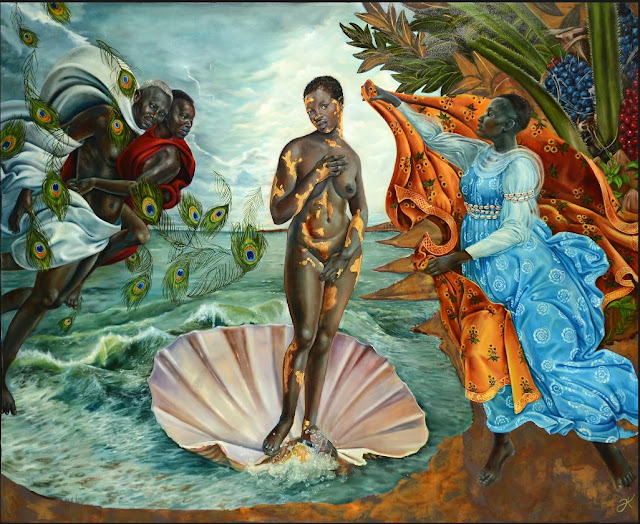A while ago—I guess it was a couple of months, more or less—an artist came to town. More exactly, it was not the artist herself but a show of her work; and the show didn't come to town so much as it came to the big State University just outside of town. But that's close enough. Admission was free, and I went to see it.
 |
| By Tmanner38 - Own work, CC BY-SA 4.0, https://commons.wikimedia.org/w/index.php?curid=113341717 |
What Rosales did—what she does—is to paint representations of the orishas, the gods of Yoruba tradition and of Santería. But she paints these figures using the arrangement and composition of famous Renaissance masterpieces. So her 2017 "Creation of God" is modeled on Michelangelo's "Creation of Adam" from the Sistine Chapel. Her "Birth of Oshun" (also from 2017) is modeled on Botticelli's "Birth of Venus."
The explanatory panels at the exhibit described at some length how Rosales "undermines" or "subverts" the Renaissance painting tradition with her works, to call attention to the peoples and traditions of Africa and the African diaspora.
But the truth is that she undermines nothing. Her painting falls squarely inside the Renaissance tradition; in fact I'd like to argue that she should be considered simply a latter-day Renaissance master. In fact, so far is she from "subverting" the Renaissance tradition that she actually uses that tradition exactly how it is supposed to be used!
After all, the point of an artistic tradition is not for everyone to paint exactly the same pictures on and on into eternity, any more than the point of a literary tradition is for everyone to write like Shakespeare or Chaucer. The whole point of a tradition in painting is to provide a common visual language so that viewers know what they are looking at. And this is where Rosales succeeds remarkably well.
Start from the idea that she wants to show us something about Santería and the orishas, a living religious tradition that those of us in the white American middle class know almost nothing of. Well and good. But if she showed us purely indigenous artwork, we would be lost. All of it would be strange and foreign, so we would not be able to distinguish signal from background. We could not tell what was important, because it would all look too strange.
But by using the composition and conventions of familiar Renaissance masterpieces, Rosales neatly avoids that problem. When we see the "Birth of Oshun," right away we understand it in the context of the "Birth of Venus." That tells us at a glance who Oshun is (because clearly she must be a goddess kind of like Venus) and why she matters. All the parts that are more or less the same as in Botticelli's painting are clearly background. And therefore we know that the rest—whatever is different—must be foreground. So we focus (at least to start) on the figure of Oshun herself: her dark skin; her African features; her short, natural hair; and the vitiligo that Rosales renders in gold leaf. What is more, when we recognize that this figure is standing in the shell where Botticelli placed Venus, we let her hold our attention; and as soon as we pay attention, we see her awesome, radiant beauty, a beauty that shines out of the painting as if the figure were alive. We let Oshun speak to us, and we let ourselves adore her.
This is surely what Rosales wants from us, or at least part of it. And it is all made possible because Rosales uses the Renaissance tradition exactly the way it was meant to be used—to serve as a common language between herself and the American professional class she is trying to reach. To reach a different audience, she might have to paint in the style of a different tradition. But this one is ours, and Rosales has shown herself a master of it. I would love to see her added into art history curricula: right after Michelangelo and Botticelli, and a little before Titian. Also I wish I could afford to own some of her work. But mostly I am grateful to know that she and her work exist, and that she has revitalized the Renaissance tradition in such vibrant and exciting ways.

No comments:
Post a Comment